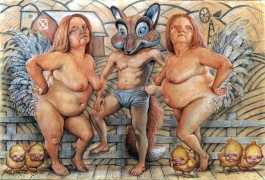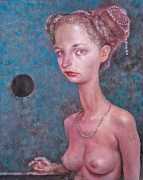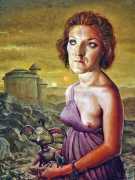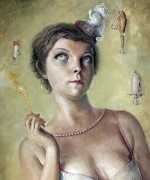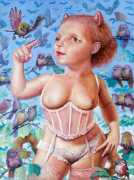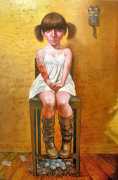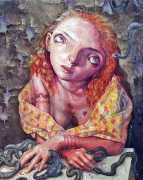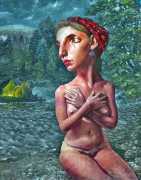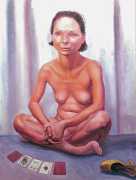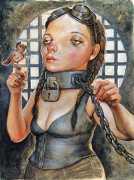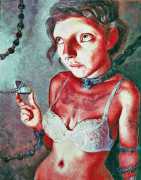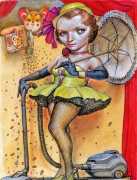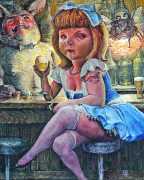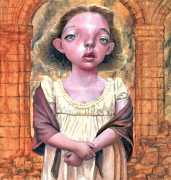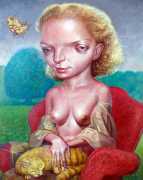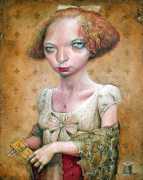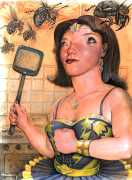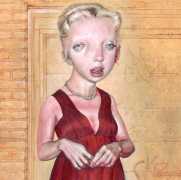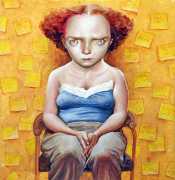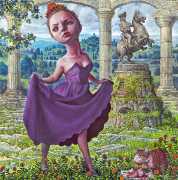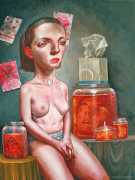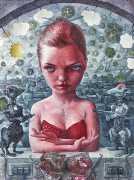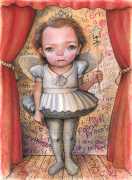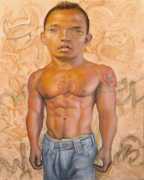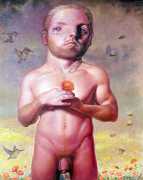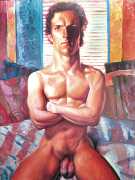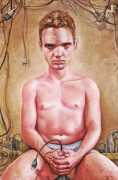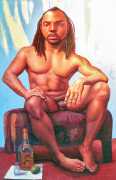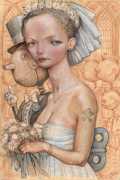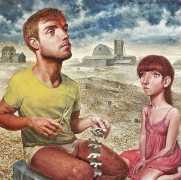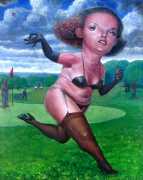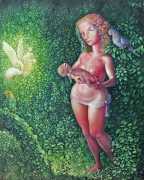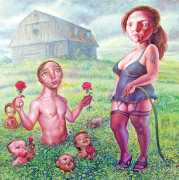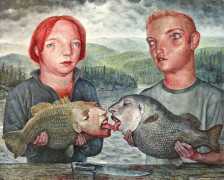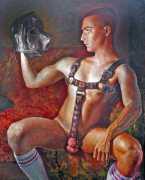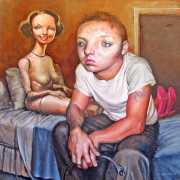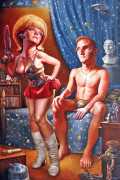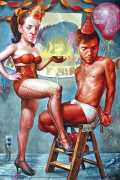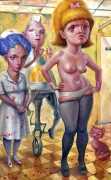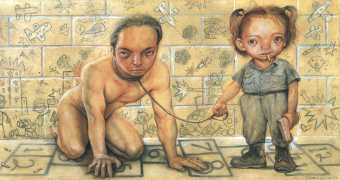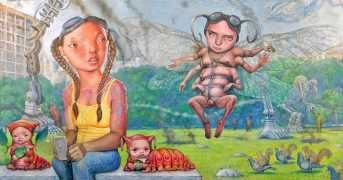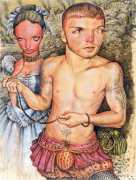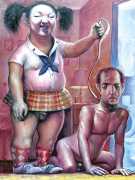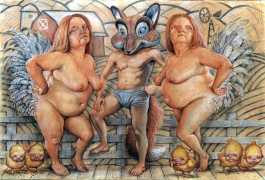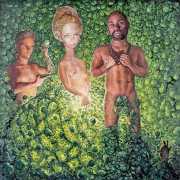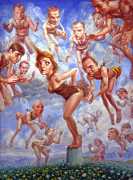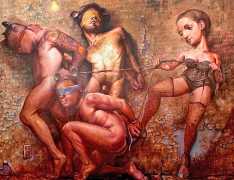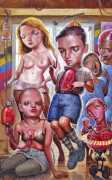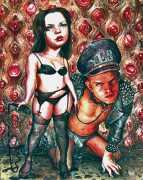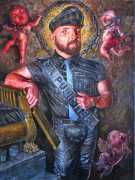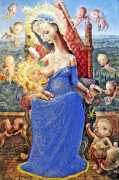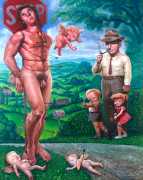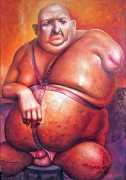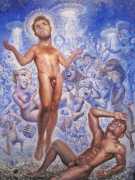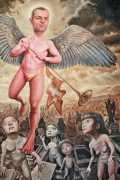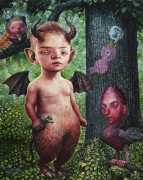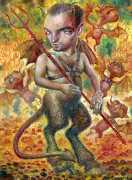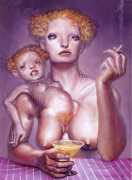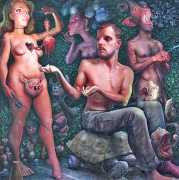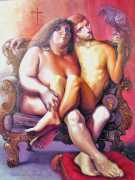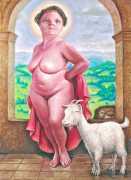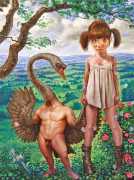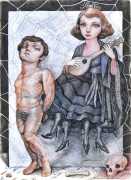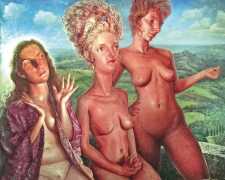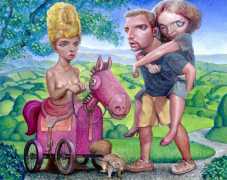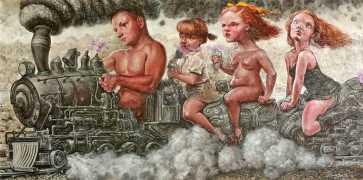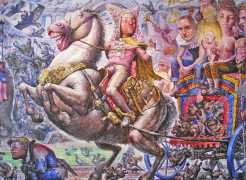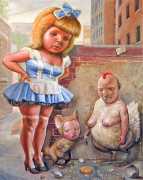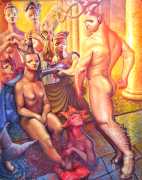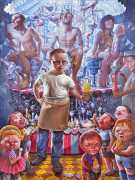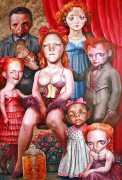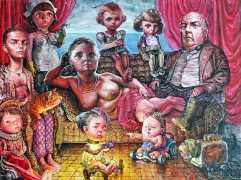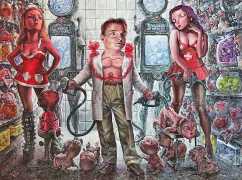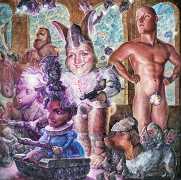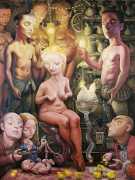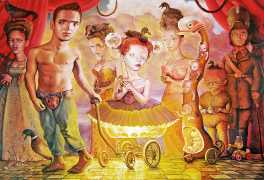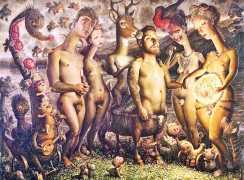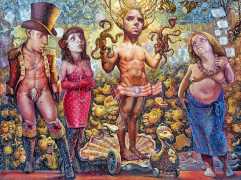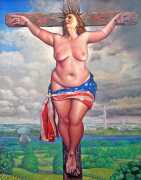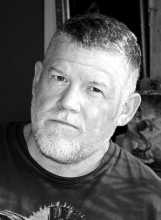 American artist Scott G. Brooks’ work borders on the surreal, ranging from portraiture to complex narratives, incorporating historical and religious imagery with current social, psychological and political issues, and infusing them with a dark sense of humour.
American artist Scott G. Brooks’ work borders on the surreal, ranging from portraiture to complex narratives, incorporating historical and religious imagery with current social, psychological and political issues, and infusing them with a dark sense of humour.
He grew up in Flint, Michigan, and has been an active painter since the age of seventeen, when he was hired to paint murals. He received a Bachelors in Fine Arts with a dual major in painting and graphic design from the University of Michigan in 1983, and moved to Washington DC in 1990, living and working there before moving to Baltimore in 2016, where he now lives with his gay artist partner and is active within the LGBTQ+ community..
Brooks paints images which provide us with a glimpse into the darker core of human existence. No subject is off limits or too challenging for him, and his canvases brim with stories which take their cues from our murky social, psychological and political lives, filtered through his offbeat approach to the absurd.
Scott Brooks has created artwork for The Washington Post, Metro Weekly, The US Forest Service and the US Navy, and has also created illustrations for children’s publications. As well as exhibitions across the USA, his work has been shown internationally, including Rome, Italy, and the Beinart Gallery in Australia.
In November 2014 WOW x WOW online magazine interviewed Scott. You can read the whole piece here; we have selected some of the more interesting responses below.
Talk to us about the themes that you like to explore with your work.
All my work is based on the figure in some way. I use models and then create something that will be fun and interesting for me to paint, and for others to enjoy. A narrative develops, sometimes simple, other times more complex. Themes incorporating sexuality, gender, society and politics interest me and often emerge, sometimes intentionally from the outset and other times developing as I work.
Your paintings tell stories. In order to achieve this, you skilfully incorporate visual cues and symbols. Please share a little about how you approach this area of your work.
It all depends on the painting. As I create the context for the figures I am constantly re-evaluating what it is saying, or what it needs to get some sense of place or motivation. I grew up reading comic books and watching lots of cartoons, so I think I developed a way to communicate using imagery. The symbolism works both ways, and I can sometimes use it to cloud my intentions, since I don’t want to give everything away. People see symbols very differently, and the range of interpretations fascinates me.
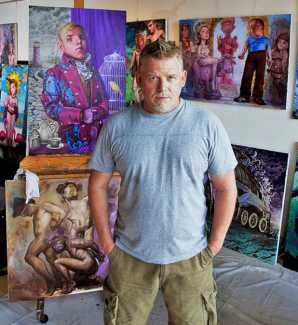 Being a figurative painter, what sort of references do you use?
Being a figurative painter, what sort of references do you use?
I hire models, or have friends come over for most of my work. We’ll have a photoshoot that lasts an hour or two, and then I print out the images. I will occasionally use an image I find online if it’s hi-res and unique, but prefer using my own photos. I currently use digital images exclusively, but have a box of old photographs I need to scan in. I can also draw relatively well from memory, and some characters are entirely made up in my head. I love working from life and draw from live models when I can, but unfortunately it’s just not possible with the type of work I do.
The figures in your paintings are cleverly stylised. You play around with the proportions of facial features and length of limbs. Have you always painted people this way, and what are the main motivations behind the look of your characters?
I began distorting the faces about fifteen years ago, and moved on to the torsos a bit later. I’m actually reversing that a bit, and the proportions are more representational in my most recent work. The distortions first appeared in my commercial illustration and cartoons, and it was a fun way to see the figure, so I started using it in my paintings. It happens pretty naturally at this point. I think it adds an element of drama and the faces feel more expressive. In the early days it was I used the distortions as a way to create a unique style. It seemed different at the time and it stuck. I see similar distortions in many other artists now. It’s been a fairly common convention throughout art history.
You always paint such colourful characters that exist in their own wonderfully unique world, far away from homogeneity. Where do you find the inspiration for them?
While my models are colourful and exist in their own unique world, that only gets me so far. The characters tend to reveal themselves while I work on a painting. I’ll work from the models as long as I can, but must keep in mind that these aren’t portraits, and that’s tougher than it sounds, especially when I’m using friends as models. I’m inspired by the people around me, the models themselves, friends, families, politicians, celebrities.
Is it important to you that the viewer gets your intended meaning, or do you feel that their interpretation of your work holds its own validity?
The viewer’s interpretation is incredibly valid, since most often their only real clue is the title. I am very entertained by what people read into my work, since It seems obvious to me. My work is a way for me to deal with events and emotions in my own life, so I’m often trying to be vague, depending on how much I feel like sharing.
How do you go about naming your paintings, and what sort of emphasis do you put on their titles?
Titles are tough, and sometimes I’ll hit on the right one early one, and other times I struggle. I’m not above using puns, or overly lyrical titles, whatever works in a pinch. It’s rare but I have several paintings where the title came first. This relates closely to the previous question, in that the title allows me some control over how viewers see the piece. I can either point them in the right direction with the title, or intentionally throw them off track if I’m feeling mysterious.
An artist’s existence can be a very solitary one. How do you like to counter balance your time in the studio?
I like the solitude and quiet, and unfortunately my schedule and social obligations make it hard to come by. When I feel the walls closing in I can turn to social media, but that can quickly become a distraction. I also switch between music, TV, movies, news, and anything else I can find to keep me going. I have a very supportive partner and that helps keep me sane-ish. I also have some great friends, many of them creative people that understand what it’s like. In the end I’m much more of an introvert, and don’t mind being alone.
Scott G. Brooks’ website can be found here, and his blog here. His Facebook page is here, and his Instagram account here.
We are very grateful to our Russian friend Yuri for suggesting the inclusion of this artist, and for supplying most of the images.

